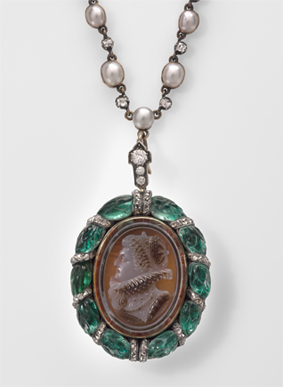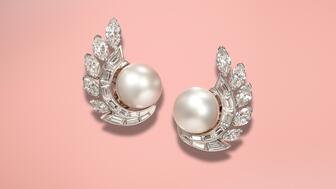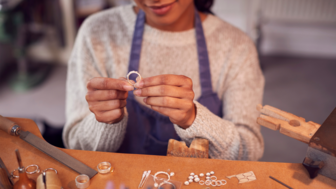An investigation found that the former managing director of Movado’s Dubai branch overstated and prematurely recorded sales.
The History Behind … Cameos
Jewelers’ love affair with cameos has been recurrent since the Roman era, and a handful of contemporary designers continue to innovate the iconic jewelry style.

New York--Iconic jewelry trends have a way of resurfacing through the centuries, and the cameo is a perfect example.
Experts say that the jewelry style enjoyed the greatest popularity during the Roman era, the Renaissance and the 19th century.

“The cameo, perhaps more than any other form of jewel, has been appreciated as a work of art and an object of virtue since ancient times through to the Renaissance era and the Neo-classical period,” said Michele Rowan, owner of antique store Rowan & Rowan and author of “Nineteenth Century Cameos.”
Today, a handful of designers make the classic style their own, whether as the signature of their brand, like Amedeo Scognamiglio, or as one element of their oeuvre, like Jacquie Aiche, Wilfredo Rosado, Lydia Courteille and Laura Lee.
National Jeweler spoke with Scognamiglio, Rowan, and Emily Stoehrer, the Rita J. Kaplan and Susan B. Kaplan Curator of Jewelry at the Museum of Fine Arts, Boston, on the cameo’s continued reemergence through the ages.
When did cameos first appear in history?
“You really see them in the Roman period,” said Stoehrer. “Then there’s a revival of them in the Renaissance period when there’s this renewed interest in classical art and then you see them go in and out of fashion in the 19th and 20th century.”
According to Stoehrer, cameos passed down through generations were sometimes repurposed, leaving the cameo itself intact but updating the setting for modernity.
This practice is still employed by designers like Aiche, who uses either vintage cameos or carved versions of her own creations, as well as Courteille.
What were they made of?
“Cameos are relief carvings, in effect miniature sculptures,” Rowan explained. “The mediums they were carved from were mainly agate or various types of shell. Gem engravers carved each stone or shell by hand to create figures or scenes, which stood proud from their background.”
“The carver exploits the different variations of color that are in the layers of shell or stone and with that they’re able to carve different motifs in low relief,” said Stoehrer.
What subjects do cameos portray?
No matter the period a cameo was created, the subject matter
“The subject matter rarely varied, most cameos--whether ancient or 17th, 18th or 19th century-- tended to depict scenes or personalities from Greek mythology. The universal appeal of tales of love, loss, deception and magic endured,” said Rowan.

“You’ll typically see allegorical themes, portraits or mythic figures like Medusa for example,” said Stoehrer.
Stoehrer noted that while mythology has been the predominant theme of cameos, some were commissioned to depict real people, a particularly good example of which can be found in bracelet-form in the Museum of Fine Arts, Boston’s permanent collection.
“The bracelet has four cameos representing the Hunt brothers,” she said. “Each one is in the likeness of one of the four brothers and it was donated to the Museum of Fine Arts by their sister.”
Who would typically buy or commission a cameo?
The MFA’s cameo collection features pieces that originated in the collections of the wealthy and influential elite, Stoehrer explained, such as one that belonged to Flemish Baroque artist Peter Paul Rubens.

Rowan explained that, later on, the owning of cameos became more democratic.
“During the 19th century, the cameo moved from the realm of the wealthy cabinet collector to a wider audience,” she said. “Increased wealth among the European middle class and increased travel meant a demand for souvenirs, especially from trips to Italy. The shell cameo industry in Italy increased in size to meet demand.”
What about the cameo’s decline after Victorian times?
In the earliest part of the 20th century, the cameo peaked.
At the time, the image of a woman wearing a choker was an extremely popular figure portrayed in cameos, so popular, said Stoehrer, that it saturated the market and fell out of favor.
As chokers became mass-produced, the quality also suffered.
“The advent of the machine-carved cameo led to a serious decline in quality,” said Rowan.
The Cameo Now
Scognamiglio’s pioneering of the ancient trend has created the cameo’s biggest contemporary success story.
Rare for a modern artist, the Italian-born designer learned to carve cameos in the ancient technique.
“My family has been making cameos since 1857, basically all branches of my paternal family have been either master carvers or cameo manufacturers, throughout two centuries,” said Scognamiglio, who nevertheless, is a self-taught carver, as his family expected his interest in cameos to be a passing fancy.
Scognamiglio started with classic themes found in Greek and Roman mythology, and mastered these before deciding to put his own stamp on the art form.
He created works depicting monkeys, skulls, elephants and crowns, combining ancient craft with rock ‘n’ roll modernity.
He explained, “I made them cool again, contemporary again. And only someone with my long heritage and family tradition, only someone from the bench like me could have done so. I decided I would revolutionize the idea of cameos.”
Scognamiglio opened a boutique in New York City in 2006, eventually expanding to also sell at other retailers. Ten years later, his business is still booming, and he’s known as “the king of cameos.”
“I thought that there was not much interest in cameos now,” said Stoehrer. “I’ve heard from different dealers that they collect dust in their show room, but I had a group in at the MFA who completely disagreed and thought that cameos were really gaining popularity right now. Maybe this is their moment.”
Scognamiglio’s works are particularly popular for their tongue-in-cheek motifs, but the designer couldn’t have created them without studying what came before.
“Evolution comes from a long way,” he said, “from research, study and classical practice.”
The Latest

The collection pays tribute to the Japanese philosophy of Ma, studying balance, stillness, and the interplay between presence and absence.

Mari Lou’s Fine Jewelry in Orland Park, a suburb of Chicago, is closing its doors.

GIA’s labs in Dubai and Hong Kong are now accepting larger diamonds in light of the “logistical challenges” presented by the new tariffs.


These earrings by Van Cleef & Arpels, featuring the same design as a pair worn by Princess Grace, are up for auction at Woolley & Wallis.

Two experts share how artificial intelligence tools can help retailers run a more efficient business.

Bench jewelers spend years honing their skills, Jewelers of America’s Certification validates their talents.

Kentaro Nishimura, who has been with the pearl company since 1997, has been promoted to president and CEO of Mikimoto America.

“America Telling Time: 150 Years of Bulova” explores the storied history of the American watchmaker.

An across-the-board tariff of 10 percent remains in place for all U.S. trading partners, except China.

Brigette Pheloung and Tania Sarin, and their mothers, star in the campaign wearing medallions they co-designed.

LeVian is remembered for her unwavering commitment to her family, community, and helping others.

The retail show is open to the public and will run July 24-27.

Editor-in-Chief Michelle Graff answers questions about how the new taxes levied on countries like India and China will impact the industry.

The new store in the upscale Iguatemi São Paulo mall is the storied brand’s first flagship in Brazil.

The pieces span from the Art Deco period to the 1970s and will go up for auction at the Paris Jewels sale later this month.

The Grammy-winning singer-songwriter, who is set to perform at Coachella this month, also debuted a curated selection from the brand.

The introductions include the Land-Dweller, Rolex’s first new model since 2012, as well as several new dials for its classic timepieces.

Cowlishaw earned a degree in horology after serving in World War II, working at one of the first Zales stores in Tulsa, Oklahoma.

Bonhams will offer the “Kat Florence Lumina” at its May 22 jewelry auction.

In March 2022, the men went into a jewelry store in Beverly Hills and smashed the display cases with sledgehammers and crowbars.

The 51 unique watches from Sotheby’s three-day sale and immersive exhibition all found buyers, with the top lot selling for $229,955.

The company has acquired Australian jewelry insurance provider Jewellers Loop.

Beau Lotto’s immersive presentation will be a blend of neuroscience, art, and entertainment.

A pink topaz Belle Époque pendant-brooch and a Victorian Egyptian Revival choker were also highlights at a recent Anderson & Garland sale.



























